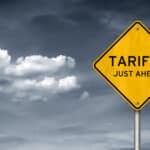Exploring the Gap Between C-Suite Rhetoric and Supply Chain Realities
What CEOs are talking about, what they are actually doing and what they should be talking about can be entirely separate things.
This is clear from the latest quarterly analysis of “What CEOs Talked About” by IOT Analytics. In Q1 2024, CEOs increasingly discussed artificial intelligence, sustainability and the upcoming elections. Company analysts use an X-axis of “keyword importance” and a Y-axis of “keyword growth” to distill topics into four quadrants of a traditional 2-by-2 decision matrix.
AI, sustainability and elections are all positioned in the “northeast quadrant” of “big and growing in importance.”
Let’s examine each quadrant.
Northeast: Chief Supply Chain Officers – Still Not Where They Should Be
My take? AI, sustainability and elections are maintaining their importance, not necessarily “growing,” as the IoT Analytics analysis asserts.
CEOs who discussed AI and sustainability more in Q1 simply did not discuss those issues enough in previous quarters. They have been massively important to business and supply chain leaders for quite some time.
The November elections for U.S. president and Congress are, of course, important. But unless you’re willing to shell out millions of dollars for one side or the other, there is not much to “learn” from this.
Like other elections, business and supply chain leaders will have to deal with the winning side’s changes in (or continuation of) policies, regulations and tax environments. That is simply a reality of being in business.
Supply chain, also, is maintaining its importance in the northeast quadrant. But my weekly discussions with supply chain leaders continue to reveal a disconnect.
Whether they are at the chief supply chain officer (CSCO) level or below, supply chain leaders do not think their concerns are heard. They still are “tabled, but not enabled.”
In other words, CEOs and other C-suite leaders are talking with supply chain leaders. But they’re still not really listening. And they’re not speaking the same language.
Smart CSCOs are recommending optionality – alternate sources for raw materials or products. But other factions still control what factories to build and where. And many C-suites still prefer single-sourced, non-resilient supply chains because of low cost.
Southeast: Tired of War, Economics? They’re Not Through Causing Disruptions
This is the “Big and fading in importance” quadrant.
Yes, all the issues in this quadrant are important. Unfortunately, many people are tired of hearing about war, recession, uncertainty, interest rates and other economic concerns.
That’s understandable. Despite how the COVID-19 pandemic accelerated history, many people don’t want to hear the word “pandemic.”
Unfortunately, business and supply chain leaders must pay attention to everything in this quadrant.
The conflict between Russia and Ukraine is hot. So are the multiple conflicts in the Middle East, which makes for dicey shipping through the Suez Canal. Traffic through that key artery dropped 50 percent in the first two months of 2024 vs. 2023, according to the International Monetary Fund.
What if those conflicts shut down the Suez Canal? It has happened before – between 1967 and 1975.
What if the simmering tensions between China, Taiwan, the Philippines, Vietnam and other Asian nations heat up into a shooting war? All claim parts of the South China Sea, a key region for global shipping, as their own. China, which maintains that Taiwan is a breakaway province, has dropped references to “peaceful reunification” in recent reports.
Remember, the United States is a major ally of Taiwan and the Philippines, raising the stakes.
What if a bridge collapses and closes an East Coast U.S. port that plays a major role in the farm equipment and automobile trade? Luckily, Baltimore is not a major port for container vessels, so the effect on global supply chains will be minimal.
Northwest: Nearshoring, Friendshoring Should Beat Out Reshoring
This “small and growing in importance quadrant” is important.
Note how a lot of key terms relate to artificial intelligence: LLM (large language modules), AI infrastructure, Nvidia, GPU, etc. Companies clearly are beyond the initial media burst over ChatGPT. Now, they are looking to integrate specialized AI technologies into their operations and serve their customers.
Labor market concerns, on the other hand, are more noise than driving forces. I have written extensively about how leaders can tap into the flexible labor market, even in the face of new independent contractor rules. That’s one of my three buckets to help you reinvent work.
This is the perfect category for reshoring. It’s important, but most reshoring will take place only in sectors that benefit from automation.
However, it seems CEOs are ignoring the key topics of nearshoring and friendshoring. With the perpetual disruptions in ocean transit and securing resources, both of those should reside in the Northeast quadrant.
Nearshoring and friendshoring manufacturing operations can keep labor costs competitive. Nearby countries also allow you to reduce transportation costs.
Southwest: Chatbots Just Aren’t that Hot Any More
Most of these are tired subjects with little impact. As you can see from the northeast and northwest quadrants, ChatGPT and Chatbots have been left behind in favor of other AI technologies.
Looking To the Future? Fix the Disconnect, Add to the Mix
As we navigate the rest of 2024 and look to 2025, CEO conversations reveal a shifting landscape.
The focus on AI and sustainability is not a sudden trend, but a necessary catch-up in discourse. Elections, while important, are a reality businesses must adapt to, rather than a learning opportunity.
The disconnect between the C-suite and supply chain leaders continues to challenge, emphasizing the need for a common language and shared understanding. And despite fatigue over discussions of war and economics, these issues remain crucial for business and supply chain leaders to monitor.
Furthermore, business leaders definitely must take stock of potential nearshoring and friendshoring opportunities. In a world of perpetual disruption, those two strategic imperatives can pave the way toward a future where you deliver to your customers – when your competition cannot.
Related Reading
- The New Era of Supply Chain Leadership: Tabled but Not Enabled
- The Chief Supply Chain Officer vs. the COO
- How Regionalization Can Be as Profitable as Globalization
- Adam Smith Wants You to Redesign Your Supply Chains
Jim Tompkins, Chairman of Tompkins Ventures, is an international authority on designing and implementing end-to-end supply chains. Over five decades, he has designed countless industrial facilities and supply chain solutions, enhancing the growth of numerous companies. He previously built Tompkins International from a backyard startup into an international consulting and implementation firm. Jim earned his B.S., M.S. and Ph.D. in Industrial Engineering from Purdue University.






